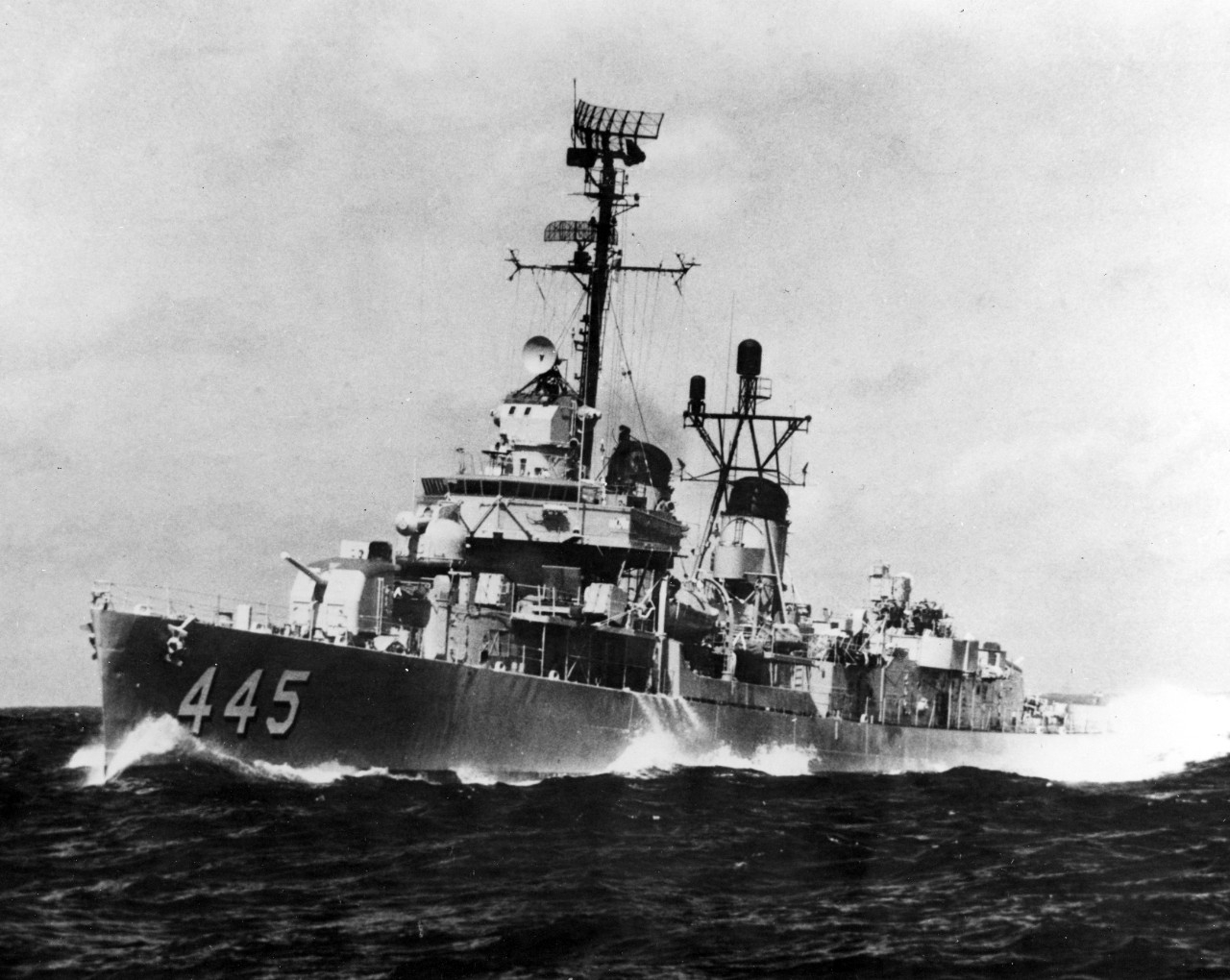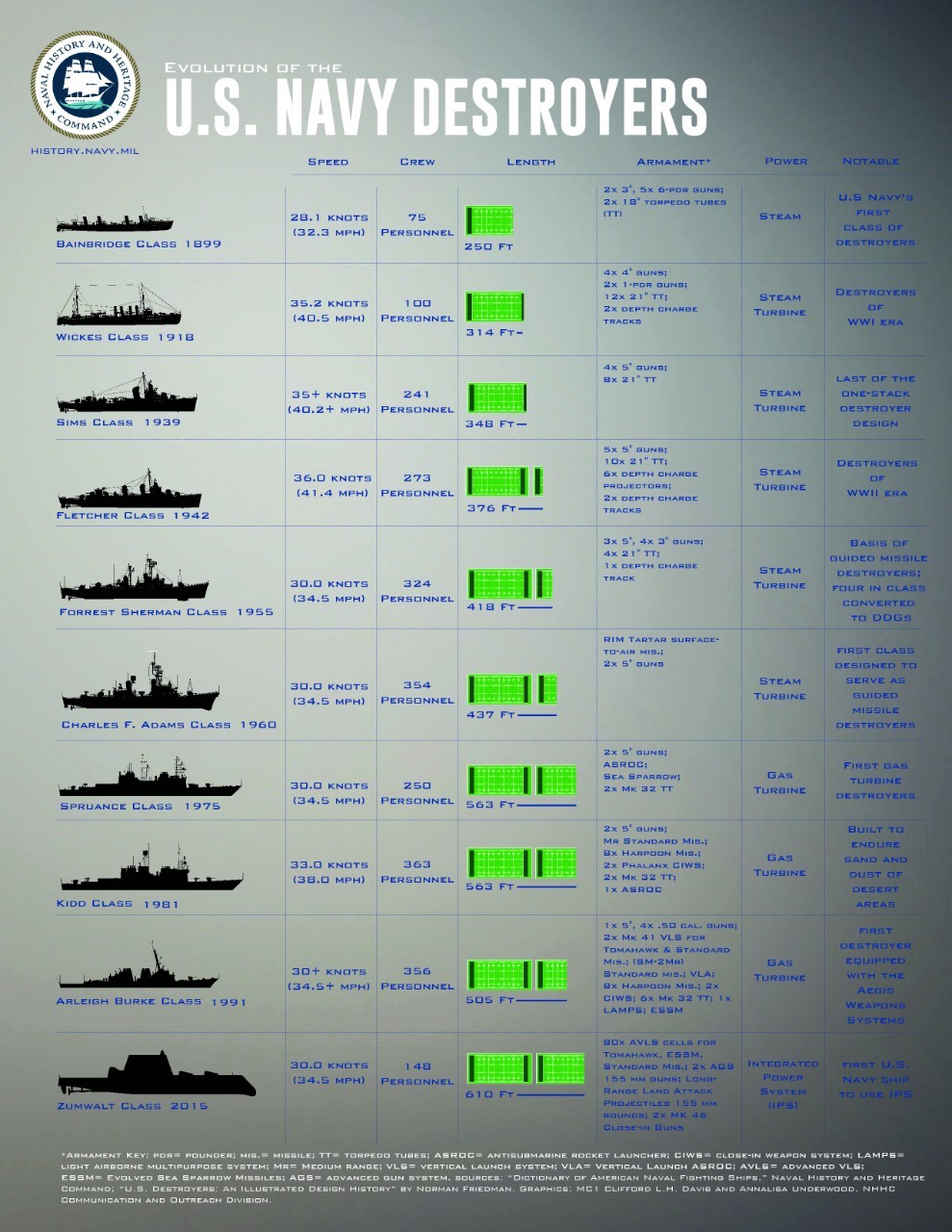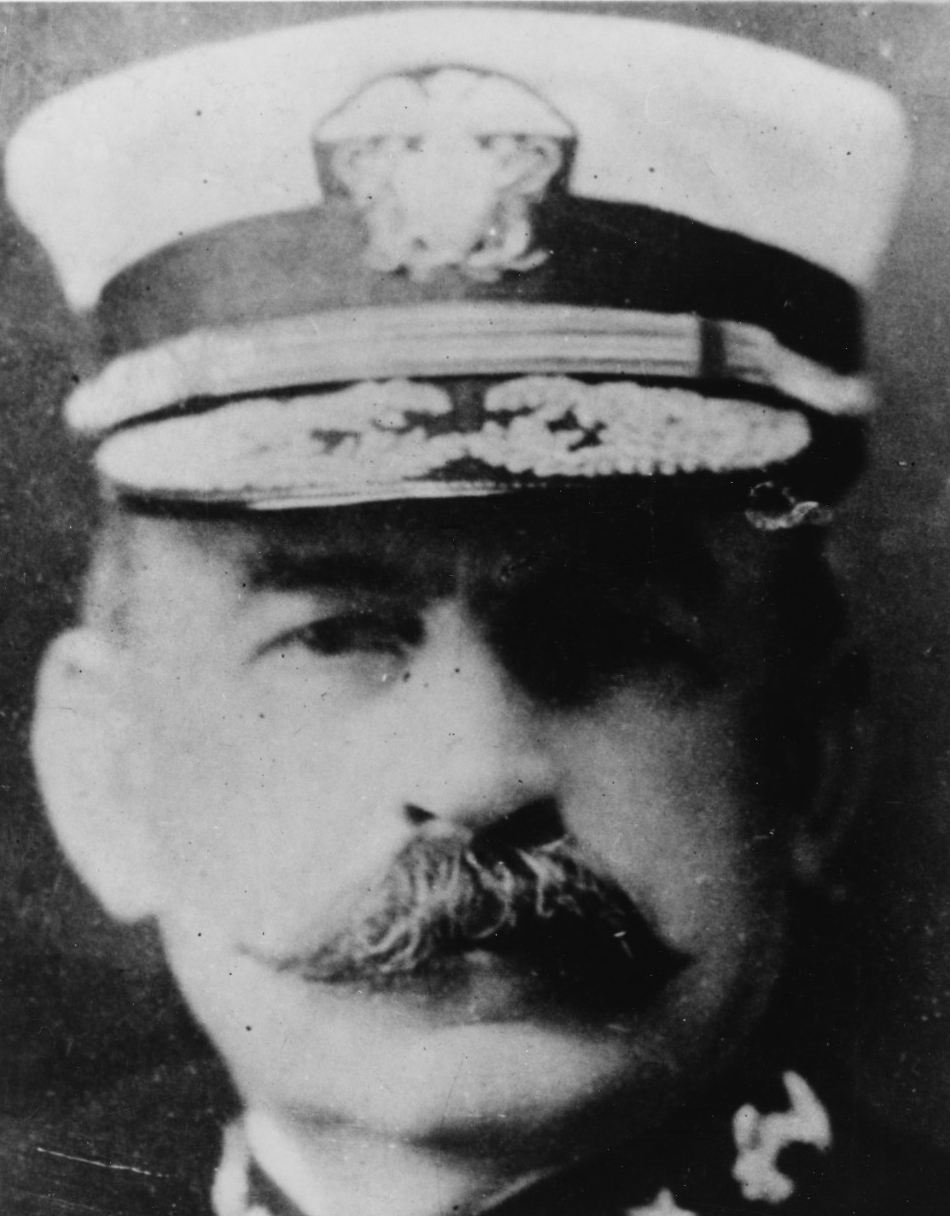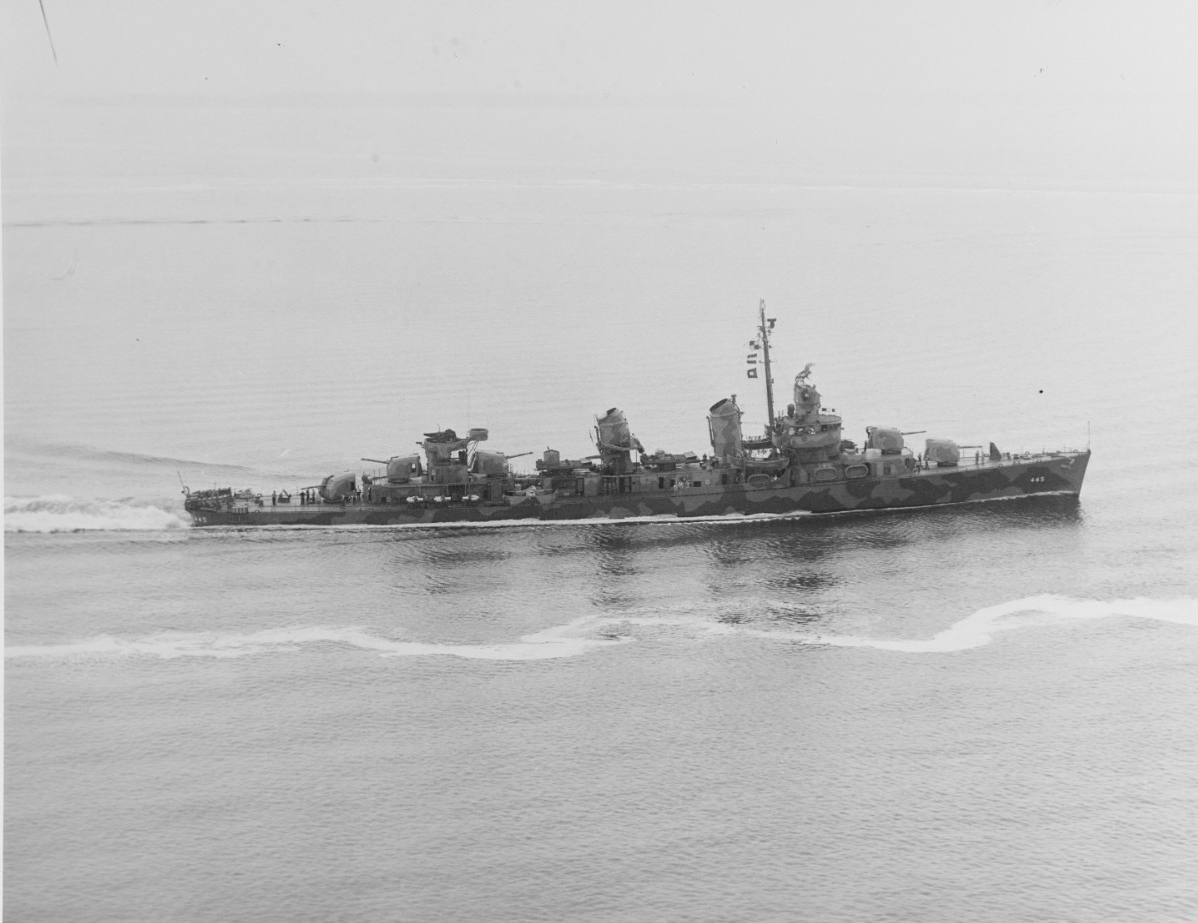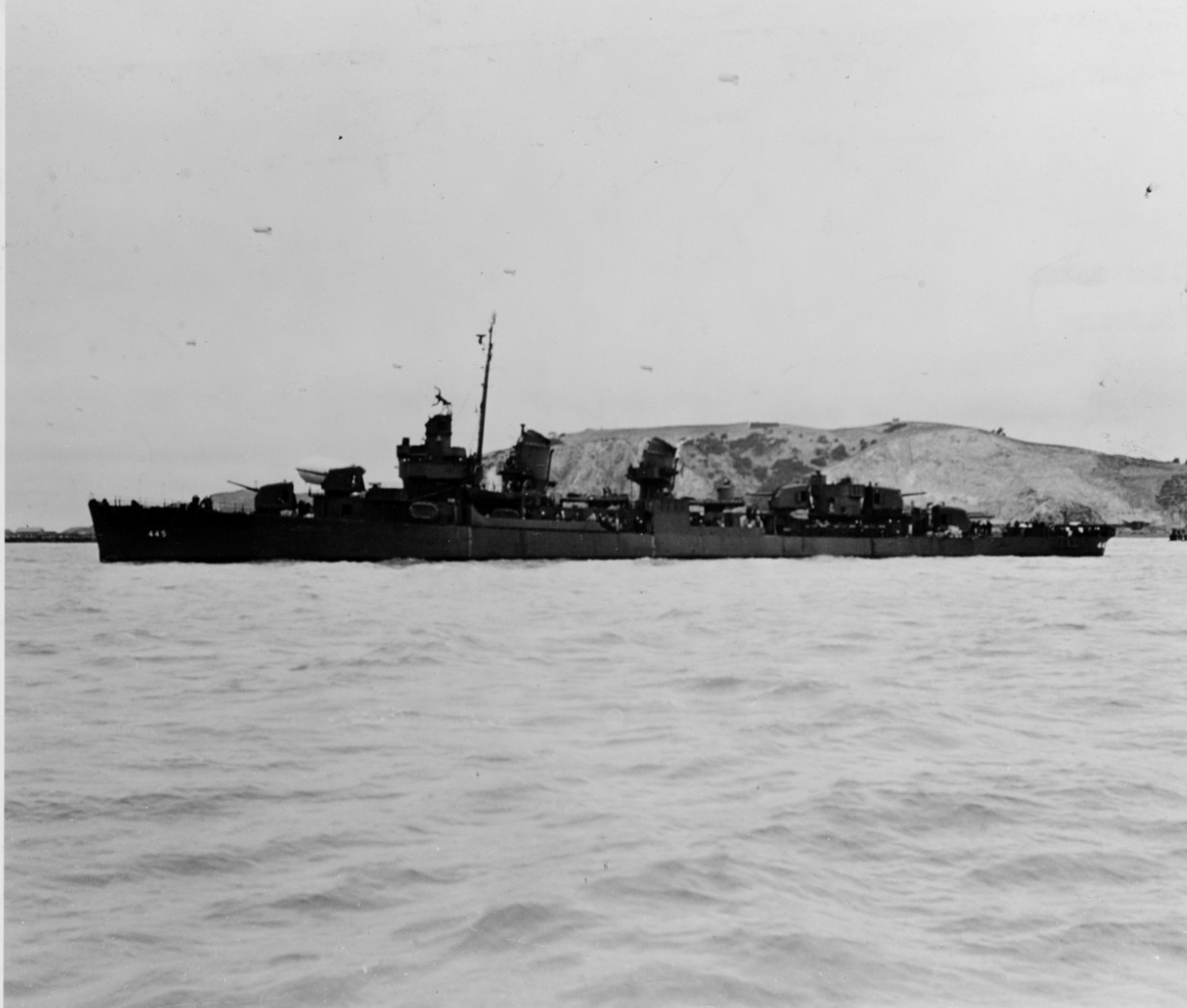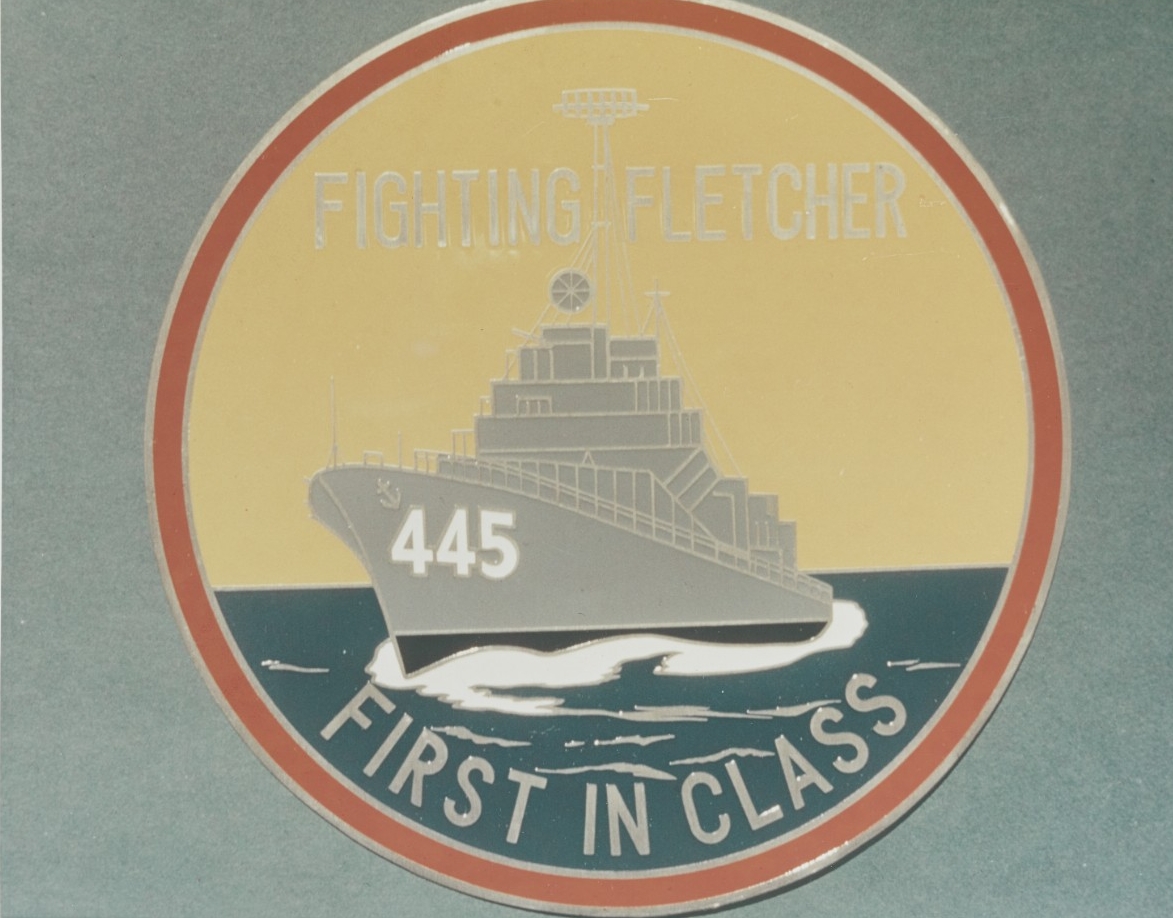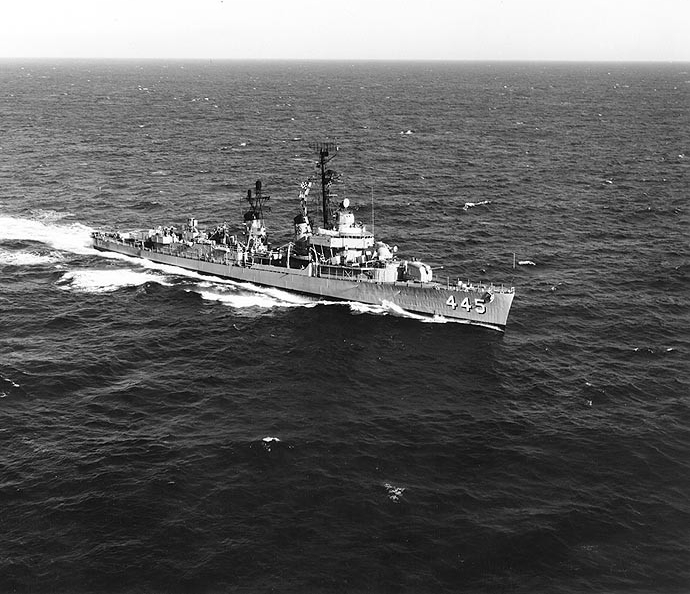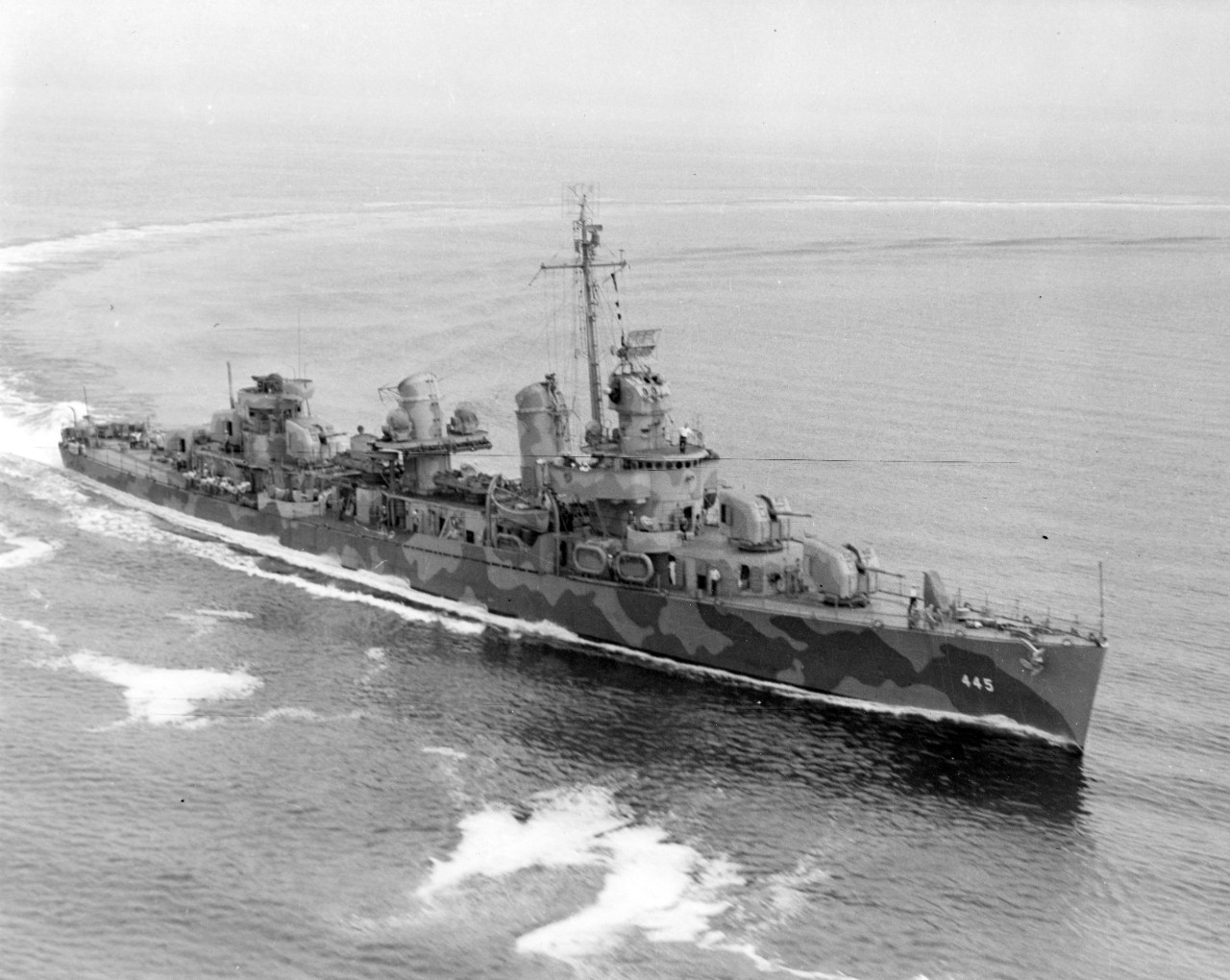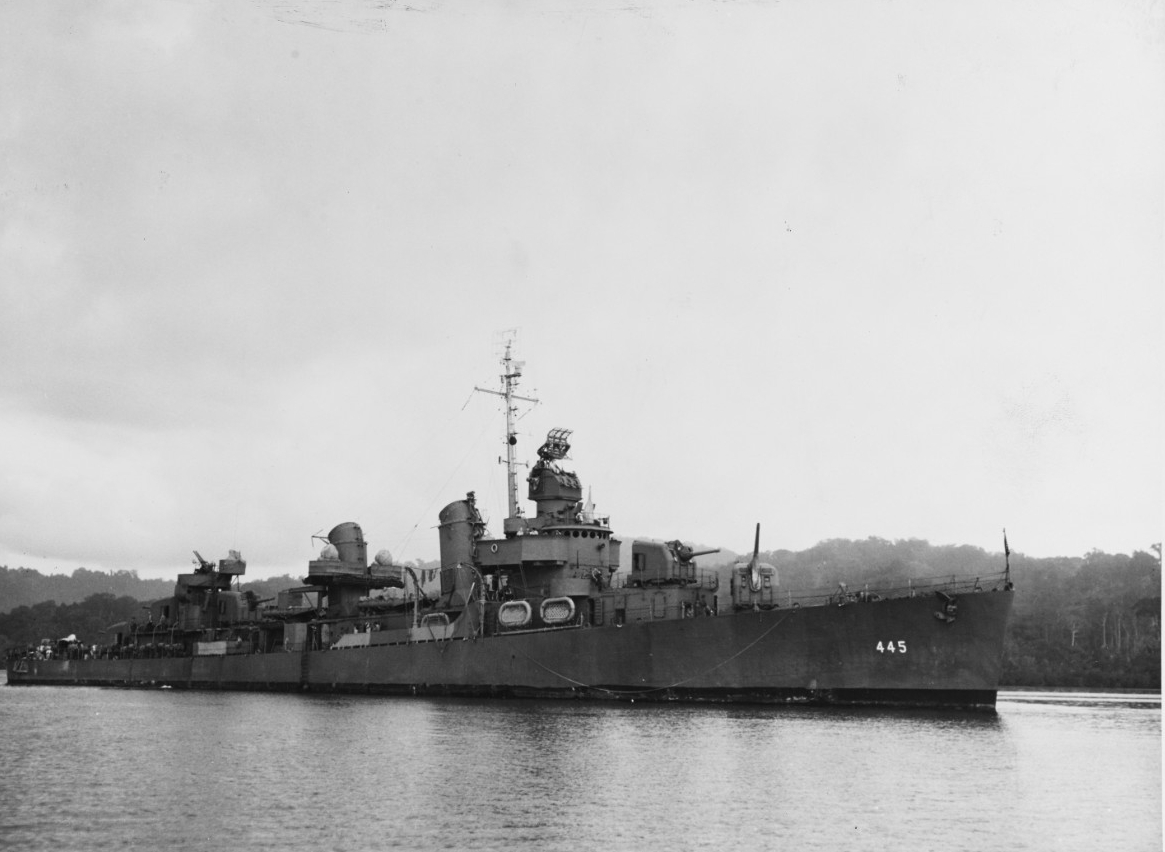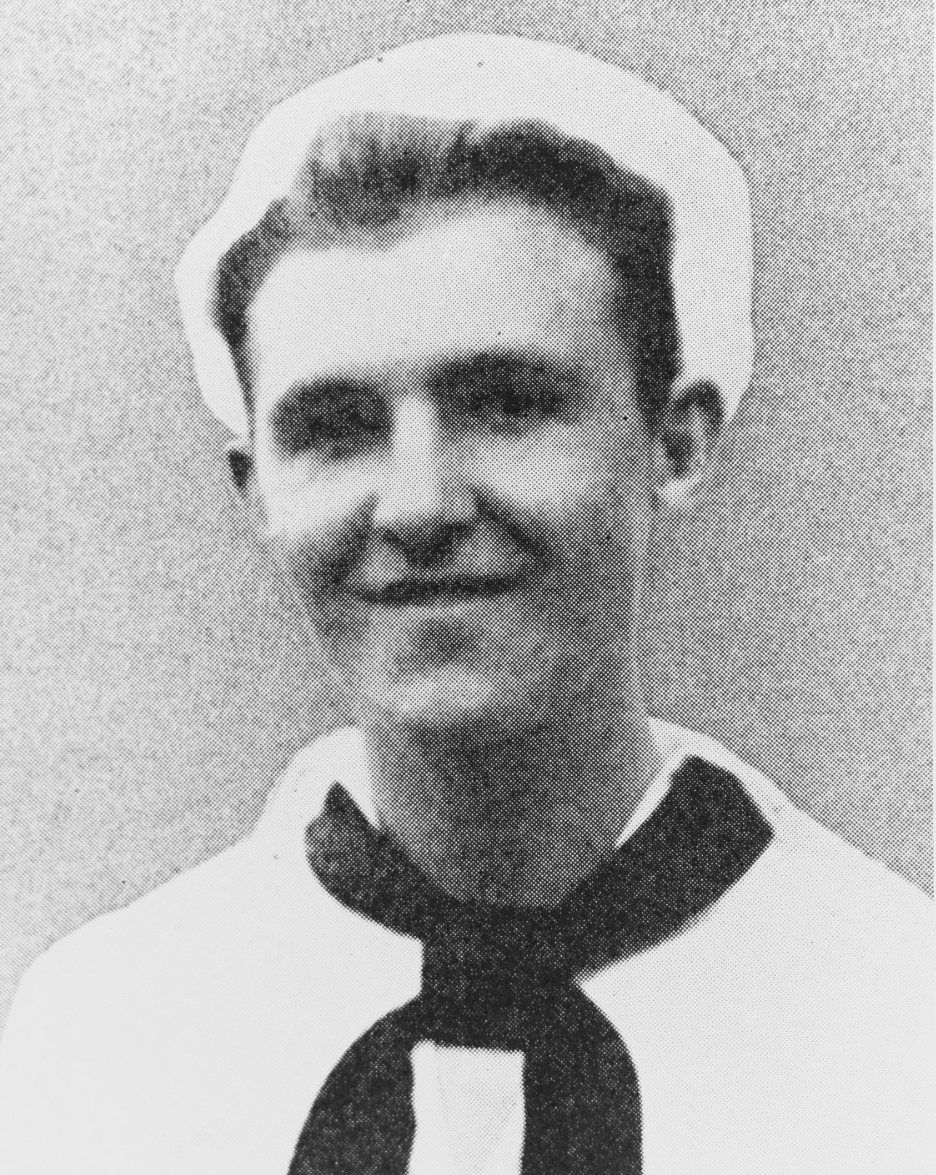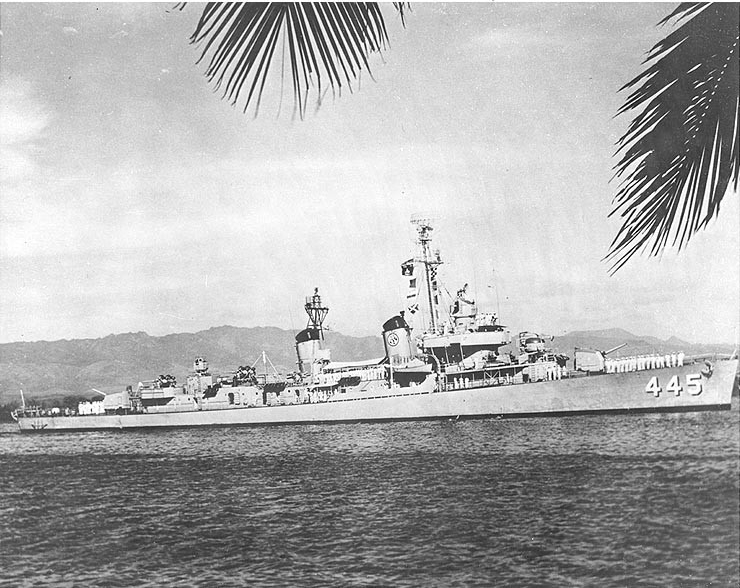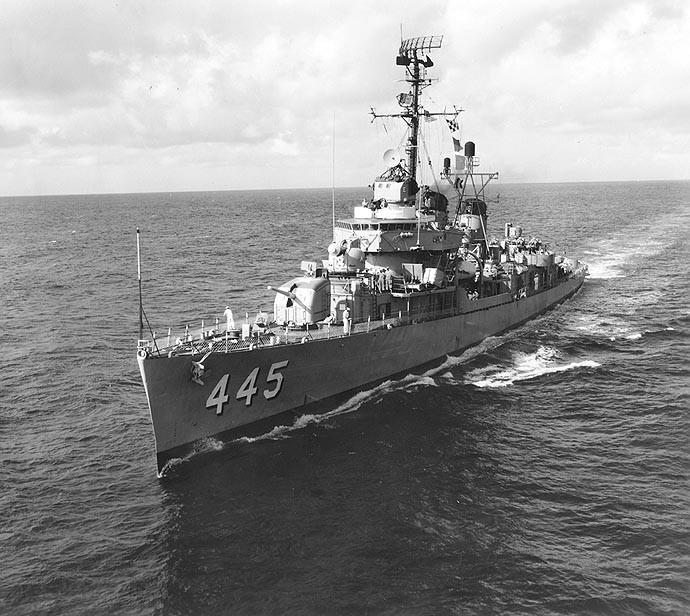USS Fletcher (DD-445)
USS Fletcher (DD-445) was commissioned on 30 June 1942, with Lieutenant Commander W. M. Cole in command. The ship was named to honor Admiral Frank Friday Fletcher, who received the Medal of Honor for his leadership during the Mexican-American War. The ship was the first of the Fletcher-class destroyers that were built during World War II.
About four months after Fletcher joined the fleet, she arrived at Noumea, New Caledonia, and began escort and patrol duty in the waters of Guadalcanal, bombarding Lunga Point on 30 October. On 9 November, she provided cover for the landings of reinforcements on the embattled island, and three days later drove off a heavy enemy aerial attack splashing several Japanese aircraft during the opening phase of the Guadalcanal campaign. On 13 November, she joined other American ships in sinking two enemy destroyers and damaging battleship Hiei, which was later sent below the waves by naval aviation. Fletcher later sought replenishment at Espiritu Santo and afterwards patrolled for enemy submarines off Noumea. On 30 November, Fletcher led the force through the Lengo Channel, and made the first radar contact with the enemy off Tassafaronga just before midnight. During the ensuing battle, the Japanese lost one destroyer and another was slightly damaged. Four American cruisers were damaged, but all but one were saved due to superb damage control measures. Notably, crewmembers from Fletcher ingeniously rigged cork-floated cargo nets to rescue groups of crewmembers from the water of the sunken cruiser USS Northampton (CA-26).
Fletcher continued to operate in the Solomons the following year patrolling, bombarding shore targets, driving off Japanese air attacks, rescuing downed aviators, destroying Japanese landing barges, and covering new landings on the northern coast of Guadalcanal. On 11 February 1943, the destroyer was alerted by a smoke float dropped by an aircraft from USS Helena (CL-50) of the presence of Japanese submarine I-18, which was subsequently attacked and sank by Fletcher. She steamed to support the landings on the Russell Islands on 21 February, and bombarded an enemy airfield on New Georgia during the night of 5–6 March.
Between late April into early May, Fletcher was in Sydney, Australia, for a well-deserved break and to get the ship in tip-top-shape for strenuous duty in the Solomons. After about a month of patrolling, she departed Espiritu Santo on 19 June for a stateside overhaul, and returned to Noumea on 27 September to resume her former patrols. On 26 November, she sortied with a carrier task group to provide air support for the invasion of the Gilbert Islands, fighting off a Japanese counter-attack. Again, Fletcher fired on Japanese aircraft on 4 December, when the task group came under heavy enemy attack after it had initially struck Kwajalein.
Fletcher returned to Pearl Harbor on 9 December, and after a brief overhaul and training on the U.S. west coast, was ready to fight in the Marshalls. She screened a group of transports from San Diego to Lahaina Roads, and then joined in the bombardment of Wotje Atoll on 30 January 1944. The next day, Fletcher joined the main attack group for the landings on Kwajalein, screening transports and patrolling off the atoll until 4 February. On 15 February, she made way to Majuro for duty screening battleships in the bombardments of Taroa and Wotje, 20–21 February, then patrolled off Eniwetok.
After training off Port Purvis, Fletcher arrived at Cape Sudest, New Guinea, on 18 April 1944, where she would remain for the next month in support of the Humboldt Bay landings. Fletcher participated in the bombardment of Ali and Seleo Islands on 23 April and covered reinforcements a week later. Later, she thwarted an attempt by the Japanese to reinforce their Biak garrison, then provided shore bombardment for the invasions of Noemfoor, Sansapor, and Morotai. Fletcher continued to operate through the summer patrolling and escorting reinforcements.
On 9 October, Fletcher reached Manus from Humboldt Bay to prepare for the Battle of Leyte Gulf. She covered American troops during the initial landings on 20 October. The next day, she departed for New Guinea and returned to Leyte with transports carrying reinforcements on 23 November. Through the next month, Fletcher supported the liberation of the Philippines, escorting convoys, bombardments at Ormoc Bay and Mindoro, and firing on Japanese aircraft in several attacks.
The following year, Fletcher made way from San Pedro Bay to provide close cover support for the Luzon Attack Force splashing several enemy aircraft along the way. After supporting the landings on Luzon, Fletcher entered Subic Bay for minesweeping operations, and then on 31 January, provided fire support for the landings in Nasugbu Bay. On 13 February, Fletcher provided bombardment support in the occupation of Bataan and Corregidor. During the operation, while firing on Japanese batteries, Fletcher took a hit, which killed eight and wounded three of her crew. She continued to fire on the enemy as damage control commenced and a half-hour later added rescue operations to her activities as she took on survivors of YMS-48, also hit by Japanese fire. Water Tender Second Class Elmer Charles Bigelow would later receive the Medal of Honor posthumously for bravery during damage control efforts. He was credited with keeping the ship’s magazine from exploding, which undoubtedly would have left the ship wallowing at the mercy of the furiously pounding Japanese guns on Corregidor.
For the remainder of the war, Fletcher took part in the landings at Puerto Princesa, Palawan, and Zamboanga, covered minesweeping and landings at Tarakan, and provided local patrol and escort service in the Philippines until 13 May, when she sailed for a west coast overhaul. World War II ended later that year. Fletcher was placed in commission in reserve and later out of commission in reserve. On 26 March 1949, Fletcher was reclassified DDE-445 and was recommissioned on 3 October as a specialist in antisubmarine warfare.
When the Korean War broke out, Fletcher was in Hong Kong with USS Valley Forge (CV-45), and on 3 July, arrived in Korean waters where she launched air strikes against North Korea. Through the summer, she patrolled the Korean Peninsula replenishing when necessary at locations such as Okinawa and Japan. From 13–17 September, Fletcher participated in the highly-successful invasion of Inchon. She returned to Pearl Harbor the next month. A year later, Fletcher returned to Korean waters where she screened the carriers of the Seventh Fleet. She also conducted shore bombardment operations, participated in antisubmarine training off Okinawa, and patrolled in the Taiwan Straits. She returned to Pearl Harbor in June 1952.
From 1954 to 1962, Fletcher annually sailed to the Far East for duty with Seventh Fleet. In 1955, she provided antisubmarine screening for the evacuation of the Tachen Islands, and in 1957 and 1958, made way to Samoa and Australia. Fletcher also served with distinction during the Vietnam War. Fletcher was decommissioned at San Diego on 1 August 1969. Although efforts were made to “save the ship,” she ultimately met the scrapper’s torch in 1972.
Fletcher received 15 battle stars for her World War II service, five for the Korean War, and seven more for her service during the Vietnam War.
*****
Suggested Reading
- H-Gram 012-1: Guadalcanal, 1942—The Battle of Friday the 13th
- H-Gram 015-2: Guadalcanal Campaign—Battle of Rennell Island and Operation Ke
- H-Gram 022-5: Battle of Vella Lavella—The Last Japanese Victory, 6–7 October 1943
- H-Gram 040-2: Leyte, Ormoc Bay, and Mindoro
- H-Gram 054-1: Inchon Landing and Naval Action in the Korean War, September−October 1950
- Naval Battle of Guadalcanal: Historical Summary by NHHC Historian Christopher B. Havern
- Surface Navy
Interviews with USS Fletcher (DD-445) crewmembers
Infographic
This infographic shares the history of U.S. Navy destroyers. The U.S. Navy's destroyers have evolved from small, fast, close-in surface combatants to multi-mission offensive and defensive warships that can operate independently or as part of strike groups. (U.S. Navy graphic by Annalisa Underwood and Mass Communication Specialist 1st Class Clifford Davis/Released)
Selected Imagery

